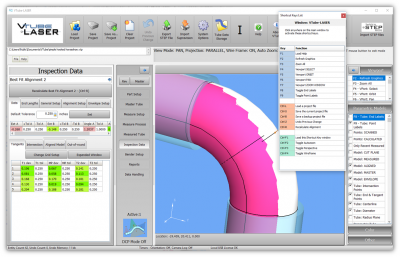Difference between revisions of "Compare UniScan to MultiScan Measurements"
(→MTA Measurements) |
|||
| Line 6: | Line 6: | ||
==Compare UniScan and MultiScan Measurements== | ==Compare UniScan and MultiScan Measurements== | ||
| + | |||
| Line 14: | Line 15: | ||
</tr> | </tr> | ||
</table> | </table> | ||
| + | |||
| + | |||
| + | |||
| + | ==Can UniScan and MultiScan Result In Different Numbers?== | ||
| + | |||
| + | |||
| + | Yes – they can give different numbers. | ||
| + | |||
| + | This is because UniScan and MultiScan cover different parts of the same straight. I trust UniScan to get me closer to the truth about the shape of the tube. Use MultiScan only when a straight is not straight (bowed) and you have to make it straight by measuring only at the two ends. | ||
| + | |||
| + | 1) UniScan covers more of the straight with more data. It will give you an average of the entire straight. | ||
| + | 2) MultiScan only covers both ends ignoring the center. | ||
| + | 3) UniScan with MTA (measured tube averaging) will give you a different result from either of the above – especially on tubes with high deformation or large diameter tubes. See the video on this page: https://www.advancedtubular.net/vtube-laser.html | ||
Revision as of 14:21, 28 March 2018
|
Compare UniScan and MultiScan Measurements |
Can UniScan and MultiScan Result In Different Numbers?
Yes – they can give different numbers.
This is because UniScan and MultiScan cover different parts of the same straight. I trust UniScan to get me closer to the truth about the shape of the tube. Use MultiScan only when a straight is not straight (bowed) and you have to make it straight by measuring only at the two ends.
1) UniScan covers more of the straight with more data. It will give you an average of the entire straight. 2) MultiScan only covers both ends ignoring the center. 3) UniScan with MTA (measured tube averaging) will give you a different result from either of the above – especially on tubes with high deformation or large diameter tubes. See the video on this page: https://www.advancedtubular.net/vtube-laser.html
UniScan Measurements
|
UniScan measurements take one group of evenly spaced points over the entire straight. The method use to measure with UniScan is like spray painting. |
MultiScan Measurements
|
MulitScan only measures near the tangents of a straight. (The tangents are the locations on the straights where the straights and bends meet.) |
MTA Measurements
| MTA (Measured Tube Averaging), combined with UniScan measuring, is the the best type of measuring available in VTube-LASER. MTA allows you to measure multiple sides of the same tube, then average the results into a single final tube shape. |
Other Pages
- Back to VTube-LASER



